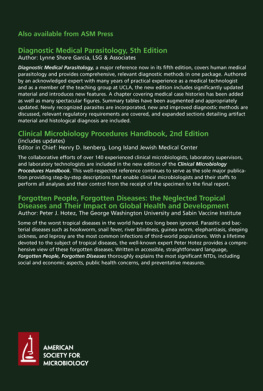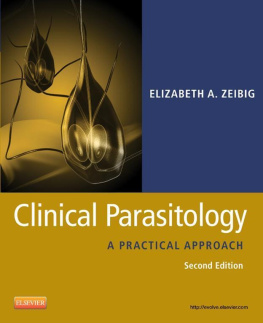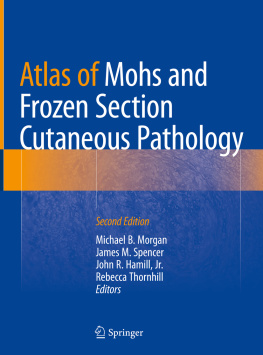PRACTICAL GUIDE TO
Diagnostic Parasitology
SECOND EDITION
Address editorial correspondence to ASM Press, 1752 N St. NW, Washington, DC 20036-2904, USA
Send orders to ASM Press, P.O. Box 605, Herndon, VA 20172, USA
Phone: 800-546-2416; 703-661-1593
Fax: 703-661-1501
E-mail:
Online: estore.asm.org
| Copyright 2009 | ASM Press
American Society for Microbiology
1752 N St. NW
Washington, DC 20036-2904 |
Library of Congress Cataloging-in-Publication Data
Garcia, Lynne Shore.
Practical guide to diagnostic parasitology / Lynne S. Garcia. 2nd ed.
p. ; cm.
Includes bibliographical references and index.
ISBN 978-1-55581-454-0 (softcover : alk. paper) 1. Diagnostic
parasitology. I. Title.
[DNLM: 1. Parasitic Diseasesdiagnosis. 2. Laboratory Techniques and
Procedures. WC 695 G216p 2009]
RC255.G37 2009
616.96075dc22 2008047918
Current printing (last digit)
10 9 8 7 6 5 4 3 2 1
All Rights Reserved
Printed in the United States of America
Cover figure: Bloodstream forms of the African trypanosome, Trypanosoma brucei, stained for a surface membrane protein (in green) and counterstained with the DNA intercalating dye DAPI, thus revealing the parasites central nucleus and posterior kinetoplast. (Courtesy of Keith Matthews and Sam Dean, University of Edinburgh.)

I dedicate the second edition of this practical guide to Robyn Shimizu. Robyn and I have worked together for many years, performing bench work, training students, presenting workshops and seminars, handling consults, performing studies, and preparing manuscripts for publication. A very special thanks to Robyn for her collaboration and supportits been quite an adventure, and were looking forward to continued collaboration.
Contents
Acknowledgments
I thank the hundreds of colleagues over the past years who have shared their thoughts and suggestions regarding this fascinating field of diagnostic parasitology. There are too many of you to nameyou all know who you are and we all recognize the pitfalls, as well as the fun, in providing diagnostic services in this field of microbiology.
I also thank the many bench techs and microbiologists who have tackled this field over the last 30+ years, including those who attended workshops and seminars; your contributions to the growth and expansion of diagnostic parasitology have been significant. Discussions of questions asked, problems for resolution, and reviews of testing options have been invaluable in shaping our approach to diagnostics in this field. This type of interaction, including the many discussions with the UCLA microbiology staff in the parasitology area, helped all of us keep an open mind when reviewing options and possible new ways to approach the work.
Over the years, our association with many companies has also been extremely valuable in helping understand test development, test trials, and relevance of results to the ultimate user within the diagnostic laboratory. Again, these interactions have helped maintain some balance and perspective on new options and their relevance to improved patient care.
A challenge to all of us who are still actively working in this area of diagnostic microbiology: serve as a mentor to some of the young people entering the field of microbiology. The number of personnel trained in this field continues to decline. Until parasite morphology is no longer required for differentiation and diagnosis, skilled microscopists will remain valuable members of the microbiology team and mandatory for the practice of diagnostic medical parasitology.
I thank Sharon Belkin for the new illustrations; she is always capable of translating my verbal descriptions into clear and accurate depictions of the various organisms. This is a true art, and she brings considerable expertise to the process; pictures are always a tremendous addition to verbal descriptions.
I also thank members of the editorial staff of ASM Press, including Susan Birch, Jeff Holtmeier, and our copy editor, Yvonne Strong; they are outstanding professionals. Susans expertise always helps the authors look good, and I appreciate her collaboration not only as an editor but also as a friend and colleague.
Above all, my very special thanks go to my husband, John, for his love and support for this and other projects over the years. I could never have taken on these challenges without his help, understanding, and wonderful sense of humor.
SECTION 1
Philosophy and Approach to Diagnostic Parasitology
Why Perform This Type of Testing?
Travel
With the increase in world travel and access to varied populations and geographic areas, we continue to see more tropical diseases and infections outside areas of endemicity due to the rapidity with which people and organisms can be transmitted from one place to another. Travel has also become accessible and more affordable for many people throughout the world, including those whose overall health status is in some way compromised. The increased transportation of infectious agents and potential human carriers, particularly via air travel, has been clearly demonstrated during the last few years. It has also been well documented that vectors carrying parasitic organisms can be transported via air travel in baggage and in the unpressurized parts of the plane itself; once released, these infected vectors can then transmit these parasites to humans, even in areas where the infections are not endemic.
Population Movements
In many parts of the world, particularly where conflict is ongoing, there continue to be large population movements. Many of these individuals become a part of refugee migrations to and from areas of endemic parasitic diseases. Often in refugee situations, living conditions are very poor and medical limitations may lead to high levels of parasitic disease and severe illness. Also, migrants may move into countries and geographic areas where serious parasitic infections are generally nonendemic, including Europe and parts of North America. Even if these individuals are uninfected when entering these areas, travel home to visit relatives may result in infections that can be imported when they return.
Control Issues
Control of parasites that cause disease is linked to a number of factors including geographic location, public health infrastructure, political stability, available funding, social and behavioral customs and beliefs, trained laboratory personnel, health care support teams, environmental constraints, degree of understanding of organism life cycles, and opportunities for control and overall commitment. Often control efforts do not cross political or geographic boundaries; unfortunately, vectors and other carriers of infectious agents do not play by the rules; as a result, these boundaries become meaningless.
Global Warming
With continued increase in the global temperature, worldwide climate changes are leading to an overall increase in infectious diseases, vector populations, and endemic ranges of both parasites and vectors. Global warming enhances the potential spread of tropical parasitic infections, specifically those due to parasites such as Plasmodium spp., Leishmania spp., and Trypanosoma spp. Examples of vectors whose range is increasing include Anopheles, Aedes, and Culex mosquitoes, hard ticks, and triatomid bugs.
Next page







